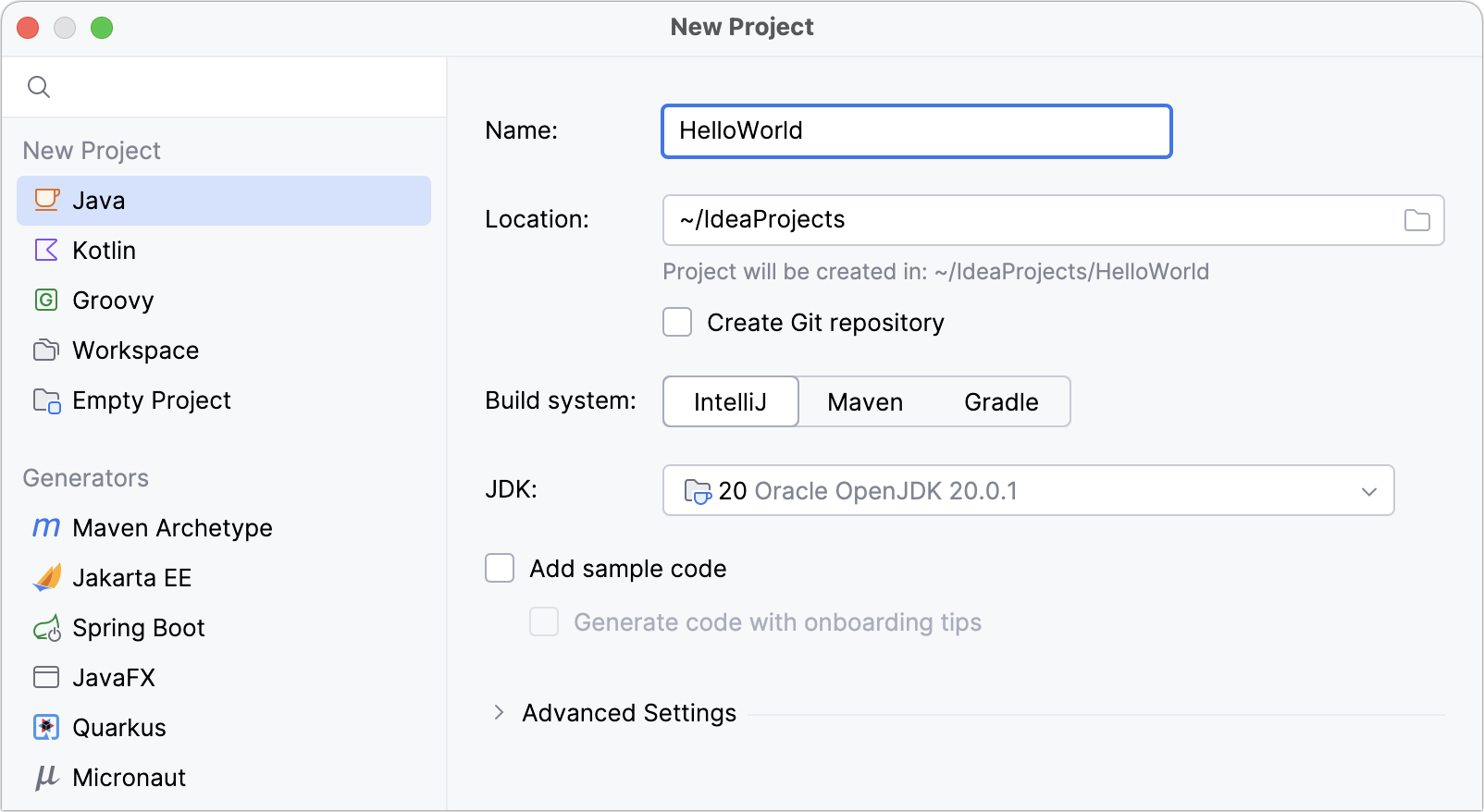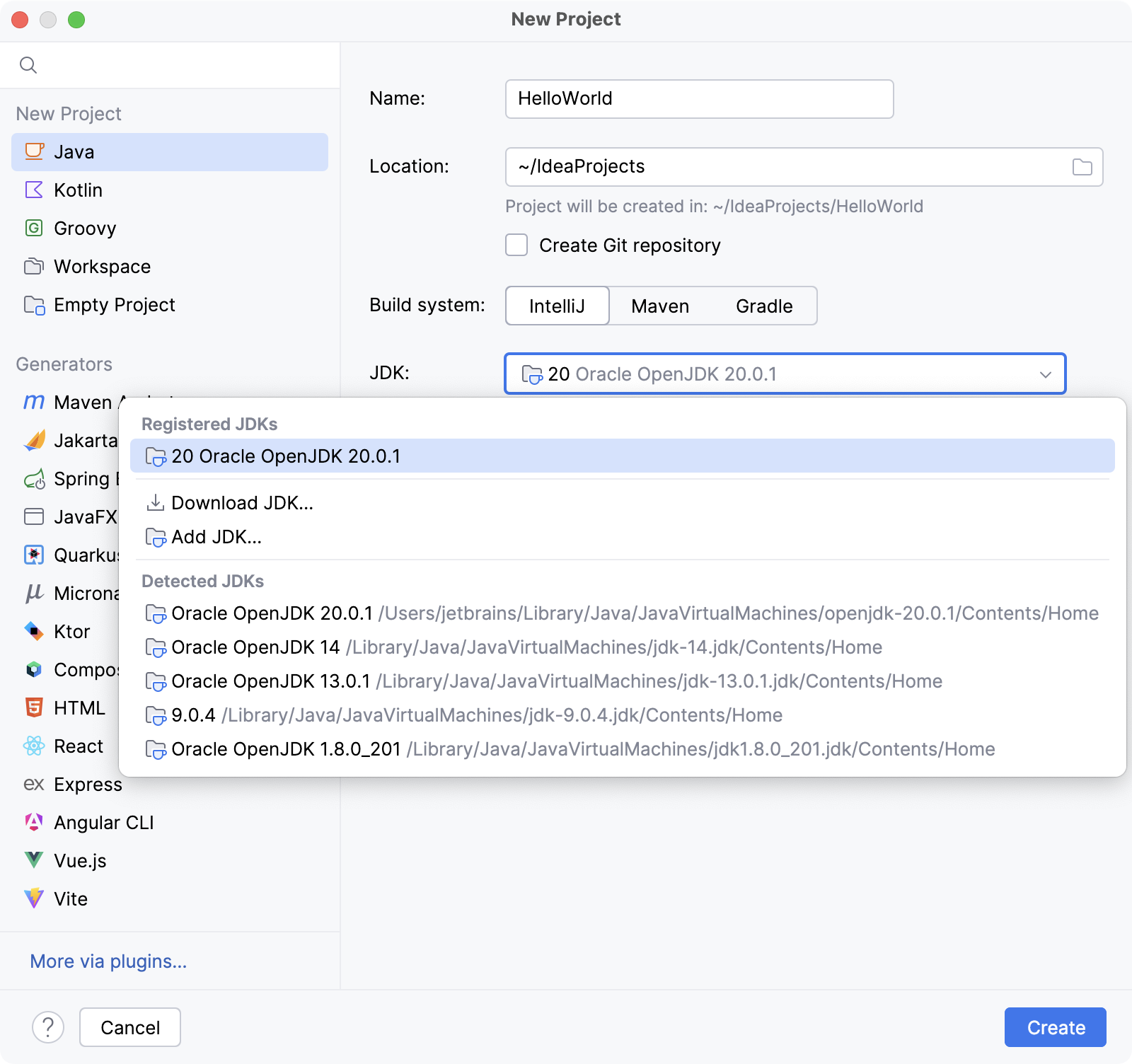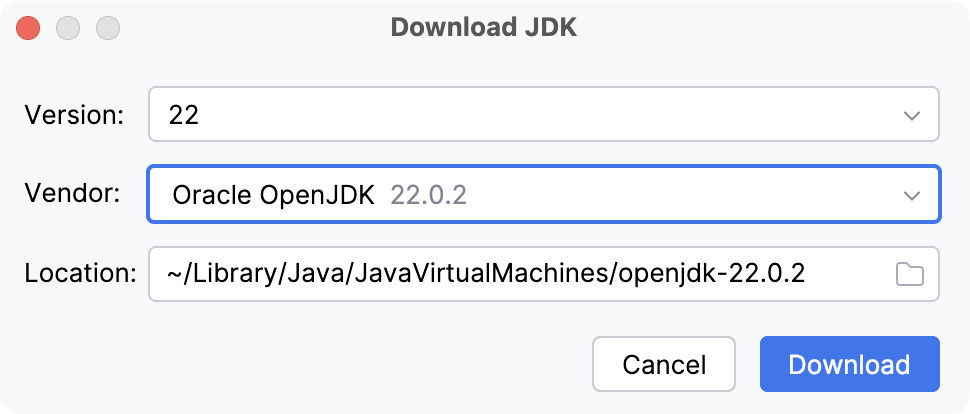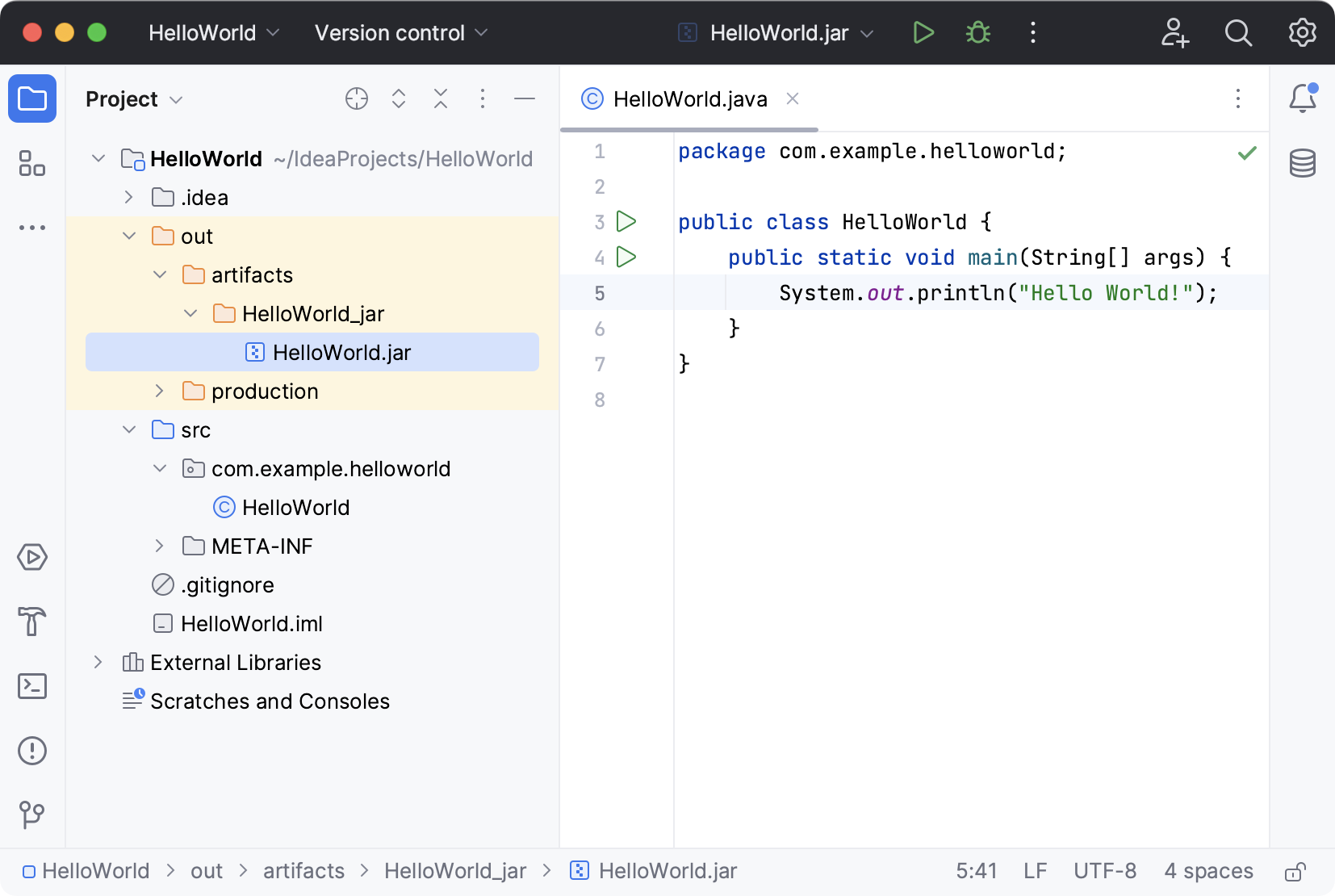Create your first Java application
In this tutorial, you will learn how to create, run, and package a simple Java application that prints Hello World! to the system output. Along the way, you will get familiar with IntelliJ IDEA features for boosting your productivity as a developer: coding assistance and supplementary tools.
In IntelliJ IDEA, a project helps you organize your source code, tests, libraries that you use, build instructions, and your personal settings in a single unit.
Launch IntelliJ IDEA.
If the Welcome screen opens, click New Project.
Otherwise, go to File | New Project in the main menu.
In the New Project wizard, select Java from the list on the left.
Name the project (for example
HelloWorld) and change the default location if necessary.We're not going to work with version control systems in this tutorial, so leave the Create Git repository option disabled.
Make sure that IntelliJ is selected in Build system.

To develop Java applications in IntelliJ IDEA, you need the Java SDK (JDK).
If the necessary JDK is already defined in IntelliJ IDEA, select it from the JDK list.
If the JDK is installed on your computer, but not defined in the IDE, select Add JDK and specify the path to the JDK home directory (for example,
/Library )./Java /JavaVirtualMachines /jdk-20.0.1.jdk 
If you don't have the necessary JDK on your computer, select Download JDK. In the next dialog, specify the JDK vendor (for example, OpenJDK), version, change the installation path if required, and click Download.

Leave the Add sample code option disabled as we're going to do everything from scratch in this tutorial. Click Create.
After that, the IDE will create and load the new project for you.
Packages are used for grouping together classes that belong to the same category or provide similar functionality as well as for structuring and organizing large applications with hundreds of classes.
In the Project tool window, right-click the src folder, select New (or press AltInsert), and then select Java Class.
In the Name field, type
com.example.helloworld.HelloWorldand click OK.IntelliJ IDEA creates the
com.example.helloworldpackage and theHelloWorldclass.
Together with the file, IntelliJ IDEA has automatically generated some contents for your class. In this case, the IDE has inserted the package statement and the class declaration.
This is done by means of file templates. Depending on the type of the file that you create, the IDE inserts initial code and formatting that is expected to be in all files of that type. For more information about how to use and configure templates, refer to File templates.
tip
The Project tool window Alt01 displays the structure of your application and helps you browse the project.
tip
In Java, there's a naming convention that you should follow when you name packages and classes.
Place the caret at the class declaration string after the opening bracket
{and press ShiftEnter.In contrast to Enter, ShiftEnter starts a new line without breaking the current one.
Type
mainand select the template that inserts themain()method declaration.As you type, IntelliJ IDEA suggests various constructs that can be used in the current context. You can see the list of available live templates using Ctrl0J.
Live templates are code snippets that you can insert into your code. main is one of such snippets. Usually, live templates contain blocks of code that you use most often. Using them can save you some time as you don't have to type the same code over and over again.
For more information about where to find predefined live templates and how to create your own, refer to Live templates.
After the main() method declaration, IntelliJ IDEA automatically places the caret at the next line. Let's call a method that prints some text to the standard system output.
Type
Syand select theSystemclass from the list of code completion suggestions (it's from the standardjava.langpackage).Press Ctrl0. to insert the selection with a trailing period.
Type
o, selectout, and press Ctrl0. again.Type
p, select the println(String x) method, and press Enter.IntelliJ IDEA shows you the types of parameters that can be used in the current context. This information is for your reference.
Type
". The second quotation mark is inserted automatically, and the caret is placed between the quotation marks. TypeHello World!
Basic code completion analyzes the context around the current caret position and provides suggestions as you type. You can open the completion list manually by pressing CtrlSpace.
For more information about different completion modes, refer to Code completion.
You can call the println() method much quicker using the sout live template.
After the main() method declaration, IntelliJ IDEA automatically places the caret at the next line. Let's call a method that prints some text to the standard system output.
Type
soutand press Enter.Type
". The second quotation mark is inserted automatically, and the caret is placed between the quotation marks. TypeHello World!.
Valid Java classes can be compiled into bytecode. You can compile and run classes with the main() method right from the editor using the green arrow icon in the gutter.
Click
in the gutter and select Run 'HelloWorld.main()' in the popup. The IDE starts compiling your code.
When the compilation is complete, the Run tool window opens at the bottom of the screen.
The first line shows the command that IntelliJ IDEA used to run the compiled class. The second line shows the program output:
Hello World!. And the last line shows the exit code0, which indicates that it exited successfully.If your code is not correct, and the IDE can't compile it, the Run tool window will display the corresponding exit code.
When you click Run, IntelliJ IDEA creates a special run configuration that performs a series of actions. First, it builds your application. On this stage, javac compiles your source code into JVM bytecode.
Once javac finishes compilation, it places the compiled bytecode to the out directory, which is highlighted with yellow in the Project tool window.
After that, the JVM runs the bytecode.
tip
Automatically created run configurations are temporary, but you can modify and save them.
tip
If you want to reopen the Run tool window, press Alt04.
IntelliJ IDEA automatically analyzes the file that is currently opened in the editor and searches for different types of problems: from syntax errors to typos. The Inspections widget in the top-right corner of the editor allows you to quickly see all the detected problems and look at each problem in detail. For more information, refer to Current file.
When the code is ready, you can package your application in a Java archive (JAR) so that you can share it with other developers. A built Java archive is called an artifact.
In the main menu, go to File | Project Structure (CtrlAltShift0S) and click Artifacts.
Click
, point to JAR and select From modules with dependencies.
To the right of the Main Class field, click
and select HelloWorld (com.example.helloworld) in the dialog that opens.
IntelliJ IDEA creates the artifact configuration and shows its settings in the right-hand part of the Project Structure dialog.
Apply the changes and close the dialog.
In the main menu, go to Build | Build Artifacts.
Point to HelloWorld:jar and select Build.

If you now look at the out/artifacts folder, you'll find your JAR there.

To make sure that the JAR artifact is created correctly, you can run it.
tip
Use Find Action CtrlShift0A to search for actions and settings across the entire IDE.
To run a Java application packaged in a JAR, IntelliJ IDEA allows you to create a dedicated run configuration.
Press CtrlShift0A, find and run the Edit Configurations action.
In the Run/Debug Configurations dialog, click
and select JAR Application.
Name the new configuration:
HelloWorldJar.In the Path to JAR field, click
and specify the path to the JAR file on your computer.
Scroll down the dialog and under Before launch, click
, select Build Artifacts | HelloWorld:jar.
Doing this means that the HelloWorld.jar is built automatically every time you execute this run configuration.
Run configurations allow you to define how you want to run your application, with which arguments and options. You can have multiple run configurations for the same application, each with its own settings.
On the toolbar, select the
HelloWorldJarconfiguration and clickto the right of the run configuration selector. Alternatively, press ShiftF10 if you prefer shortcuts.
As before, the Run tool window opens and shows you the application output.
The process has exited successfully, which means that the application is packaged correctly.
Thanks for your feedback!